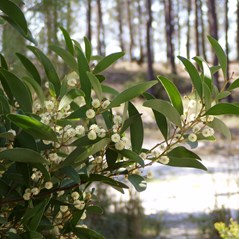Uses: Attractive feature or shade tree in broad streetscapes, reserves and parks. Not suitable for narrow streetscapes, under power lines or close to pipes or drains. Long lived and does not shed limbs as frequently as some eucalypts and other acacia species. Attracts birds, native butterflies and insects, caterpillar food plant.
Cultural use: Wood and fibre used for fishing lines, spear throwers, shields, throwing sticks, bark infusion for rheumatic joints by indigenous peoples. Seed were ground and eaten.
Note: This species is classified schedule 2, Regulation 24.3 under the Sewerage Act and may be planted in any street or road in any drainage area provided they are not planted closer than 3.5 metres to any sewer main or connection. They should not be planted closer than 3.5 metres to any sewer pipe in home gardens.
Note: Fire retardant plant as per SA Country Fire Service, contact for further information.
This plant is indigenous to the following botanical regions of South Australia.
:FR: Flinders Rangers
:NL: Northern Lofty
:MU: Murray
:SL: Southern Lofty
:KI: Kangaroo Island
:SE: South Eastern
For detail on these regions refer to the user guide.
- Canopy Shape Open
- Height 7-20m
- Spread 4-10m
- Position
- Full Sun
- Part Shade
- Family Fabaceae
- Botanical Name Acacia melanoxylon
- Common Name Blackwood
- Origin SA, Vic, NSW, Qld, Tas
- Habit Upright, Dense
- Landscape Coast, 2nd line coast, Coastal footslopes, Plains, Hills
- Soil Texture Clay, Loam, Sand
- pH Acidic, Alkaline, Neutral
- Tolerates Drought, Fire, Moderate frost, Soil salinity
- Supplementary Watering Moderate
- Flower Colour Cream, Yellow
- Flowering Time Spring, Winter
- Foliage Dark-green
- Flower Type Globular
- Purpose Shade, Bush food
- Evergreen/Deciduous Evergreen
- Seasonal Colour Winter
- Trunk Rough
- Form Tall Tree (Usually exceeds 10m)







